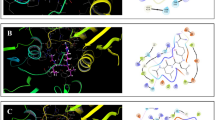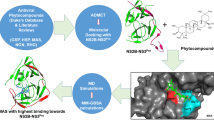Abstract
Dengue virus (DENV) infection is one of the largest threats worldwide, and there is no any specific drug available in the market to combat its serious causes. In the present study, we attempted to screen the potential of green tea to inhibit DENV infection through known DENV multi-target, viz. nonstructural protein 1 (NS1), RNA dependent RNA polymerase domain (RDRP), and methyltransferase domain of non-structural protein 5 (MTD). A total of 25 bioactive compounds from the green tea were docked against the selected targets that result into only three compounds with substantial binding affinity above − 9 kcal/mol. Evaluation of these docked complexes through molecular dynamics simulations suggested the considerable stability of Compound-1 and Compound-2 with selected DENV targets whilst no significant stability was recorded for the Compound-3. Hence, Compound-1 and Compound-2 were concluded with potential inhibitory activity against DENV NS1, RDRP, and MTD; and suggested to validate their anti-dengue activity through in vitro and in vivo experiments.





Similar content being viewed by others
Change history
23 July 2020
In results and discussion section, the description of figures was revised as follows. In the case of NS1-Compound-1 complex, consider an additional contact of Glu12 (Fig. 1a), in case of NS1-Compound-2 complex, six instead of four residues were involved in contact (Fig. 1b). In case of RDRP-Compound-1 complex, seven instead of three hydrogen bonds were formed (Fig. 1d), while in case of RDRP Compound-2 complex nine instead of seven hydrogen bonds were recorded (Fig. 1e). In case of MTD-complex 1 consider an addition contact of Leu17 (Fig. 1g).
References
Akey DL, Brown WC, Dutta S, Konwerski J, Jose J, Jurkiw TJ, DelProposto J, Ogata CM, Skiniotis G, Kuhn RJ, Smith JL (2014) Flavivirus NS1 structures reveal surfaces for associations with membranes and the immune system. Science 343:881–885
Allonso D, Andrade IS, Conde JN, Coelho DR, Rocha DC, da Silva ML, Ventura GT, Silva EM, Mohana-Borges R (2015) Dengue virus NS1 protein modulates cellular energy metabolism by increasing glyceraldehyde-3-phosphate dehydrogenase activity. J Virol 89:11871–11883
Anciotti RS, Gubler DJ, Trent DW (1997) Molecular evolution and phylogeny of dengue-4 viruses. J Gen Virol 78:2279–2286
Anderson CR, Downs WG, Hill AE (1956) Isolation of dengue virus from a human being in Trinidad. Science 124:224–225
Bartholomeusz AI, Wright PJ (1993) Synthesis of dengue virus RNA in vitro: initiation and the involvement of proteins NS3 and NS5. Arch Virol 128:111–121
Benarroch D, Egloff MP, Mulard L, Guerreiro C, Romette JL, Canard B (2004) A structural basis for the inhibition of the NS5 dengue virus mRNA 2′-O-methyltransferase domain by ribavirin 5′-triphosphate. J Biol Chem 279:35638–35643
Berman HM, Westbrook J, Feng Z, Gilliland G, Bhat TN, Weissig H, Shindyalov IN, Bourne PE (2000) The protein data bank. Nucleic Acids Res 28:235–242
Bowers KJ, Chow E, Xu H, Dror RO, Eastwood MP, Brent A et al (2006) Scalable algorithms for molecular dynamics simulations on commodity clusters. In: Proceedings of the ACM/IEEE conference on supercomputing (SC06), Tampa, Florida, 2006, November 11–17
DeLano WL (2002) The PyMOL molecular graphics system. http://pymol.org
Dwivedi VD, Tripathi IP, Mishra SK (2016) In silico evaluation of inhibitory potential of triterpenoids from Azadirachta indica against therapeutic target of dengue virus, NS2B-NS3 protease. J Vect Borne Dis 53:156–161
Dwivedi VD, Tripathi IP, Tripathi RC, Bharadwaj S, Mishra SK (2017) Genomics, proteomics and evolution of dengue virus. Brief Funct Genom 16:217–227
Gubler DJ (1998) Dengue and dengue hemorrhagic fever. Clin Microbiol Rev 11:480–496
Guzman MG, Alvarez M, Halstead SB (2013) Secondary infection as a risk factor for dengue hemorrhagic fever/dengue shock syndrome: an historical perspective and role of antibody-dependent enhancement of infection. ArchVirol 158:1445–1459
Hanley KA, Weaver SC (eds) (2010) Frontiers in dengue virus research. Caister Academic Press, Hethersett
Ismail NA, Jusoh SA (2017) Molecular docking and molecular dynamics simulation studies to predict flavonoid binding on the surface of DENV2 E protein. Interdiscip Sci Comput Life Sci 9:499–511
Kim S, Thiessen PA, Bolton EE, Chen J, Fu G, Gindulyte A, Han L, He J, He S, Shoemaker BA, Wang J (2015) PubChem substance and compound databases. Nucleic Acids Res 44:1202–1213
Labbé CM, Rey J, Lagorce D, Vavruša M, Becot J, Sperandio O, Villoutreix BO, Tufféry P, Miteva MA (2015) MTiOpenScreen: a web server for structure-based virtual screening. Nucleic Acids Res 43:448–454
Laskowski RA, Mark BS (2011) LigPlot + : multiple ligand–protein interaction diagrams for drug discovery. J Chem Inf Model 51:2778–2786
Lim SP, Noble CG, Shi PY (2015) The dengue virus NS5 protein as a target for drug discovery. Antiviral Res 119:57–67
MAESTRO, SCHRÖDINGER, LLC: Schrödinger release 2018-3
Low JG, Sung C, Wijaya L, Wei Y, Rathore AP, Watanabe S, Tan BH, Toh L, Chua LT, Chow A, Howe S (2014) Efficacy and safety of celgosivir in patients with dengue fever (CELADEN): a phase 1b, randomised, double-blind, placebo-controlled, proof-of-concept trial. Lancet Infect Dis 14:706–715
Malet H, Masse N, Selisko B, Romette JL, Alvarez K et al (2008) The flavivirus polymerase as a target for drug discovery. Antiviral Res 80:23–35
Meng F, Badierah RA, Almehdar HA et al (2015) Unstructural biology of the dengue virus proteins. FEBS J282:3368–3394
Mustafa MS, Rasotgi V, Jain S et al (2015) Discovery of fifth serotype of dengue virus (DENV-5): a new public health dilemma in dengue control. Med JArmed Forces India 71:67–70
Noble CG, Lim SP, Arora R, Yokokawa F, Nilar S, Seh CC, Wright SK, Benson TE, Smith PW, Shi PY (2016) A conserved pocket in the dengue virus polymerase identified through fragment-based screening. J Biol Chem 291:8541–8548
Normile D (2013) Surprising new dengue virus throws a spanner in disease control efforts. Science 342:415
Perera R, Kuhn RJ (2008) Structural proteomics of dengue virus. Curr Opin Microbiol 11:369–377
Pettersen EF, Goddard TD, Huang CC, Couch GS, Greenblatt DM, Meng EC, Ferrin TE (2004) UCSF Chimera—a visualization system for exploratory research and analysis. J Comp Chem 25:1605–1612
Rodenhuis-Zybert IA, Wilschut J, Smit JM (2010) Dengue virus life cycle: viral and host factors modulating infectivity. Cell Mol Life Sci 67:2773–2786
Russell PK, Buescher EL, McCown JM et al (1966) Recovery of dengue viruses from patients during epidemics in Puerto Rico and East Pakistan. Am J Trop MedHyg 15:573–579
Sabin AB, Schlesinger RW (1945) Production of immunity to dengue with virus modified by propagation in mice. Science 101:640–642
Sarkar JK, Chatterjee SN, Chakravarty SK (1964) Haemorrhagic fever in calcutta: some epidemiological observations. Indian J Med Res 52:651–659
Schmidtke P, Le Guilloux V, Maupetit J, Tuffery P (2010) Fpocket: online tools for protein ensemble pocket detection and tracking. Nucleic Acids Res 38:582–589
Schrödinger Release 2018–3: Desmond Molecular Dynamics System, D. E. Shaw Research, New York, NY (2018) Maestro-Desmond Interoperability Tools. Schrödinger, New York, p 2018
Selisko B, Wang C, Harris E, Canard B (2014) Regulation of Flavivirus RNA synthesis and replication. Curr Opin Virol 9:74–83
Simmons CP, Farrar JJ, Van VCN et al (2012) Dengue. New Eng J Med 366:1423–1432
Tam DT, Ngoc TV, Tien NT, Kieu NT, Thuy TT, Thanh LT, Tam CT, Truong NT, Dung NT, Qui PT, Hien TT (2012) Effects of short-course oral corticosteroid therapy in early dengue infection in Vietnamese patients: a randomized, placebo-controlled trial. Clin Infect Dis 55:1216–1224
Tricou V, Minh NN, Van TP, Lee SJ, Farrar J, Wills B, Tran HT, Simmons CP (2010) A randomized controlled trial of chloroquine for the treatment of dengue in Vietnamese adults. PLoS Neglec Trop Dis 4:e785
Vázquez-Calvo Á, Jiménez de Oya N, Martín-Acebes MA, Garcia-Moruno E, Saiz JC (2017) Antiviral properties of the natural polyphenols delphinidin and epigallocatechin gallate against the flaviviruses West Nile virus, Zika virus, and dengue virus. Front Microbiol 8:1314
Whitehorn J, Nguyen CV, Khanh LP, Kien DT, Quyen NT, Tran NT, Hang NT, Truong NT, Hue Tai LT, Cam Huong NT, Nhon VT (2016) Lovastatin for the treatment of adult patients with dengue: a randomized, double-blind, placebo-controlled trial. Clin Infect Dis 62:468–476
Xu J, Xu Z, Zheng W (2017) A review of the antiviral role of green tea catechins. Molecules 22:1–18
Acknowledgements
All the authors of this manuscript acknowledge Center for Bioinformatics, Computational and Systems Biology, Pathfinder Research and Training Foundation, Greater Noida, India for providing laboratory facilities.
Author information
Authors and Affiliations
Corresponding authors
Ethics declarations
Conflict of interest
Authors declare that there is no competing interest.
Additional information
Publisher's Note
Springer Nature remains neutral with regard to jurisdictional claims in published maps and institutional affiliations.
Electronic supplementary material
Below is the link to the electronic supplementary material.
Rights and permissions
About this article
Cite this article
Mahajan, P., Tomar, S., Kumar, A. et al. A multi-target approach for discovery of antiviral compounds against dengue virus from green tea. Netw Model Anal Health Inform Bioinforma 9, 20 (2020). https://doi.org/10.1007/s13721-020-0222-4
Received:
Revised:
Accepted:
Published:
DOI: https://doi.org/10.1007/s13721-020-0222-4




